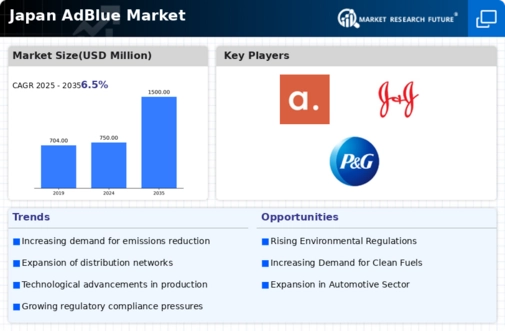Market Growth Projections
The Global Japan AdBlue Market Industry is poised for substantial growth, with projections indicating a market value of 750 USD Million in 2024 and an anticipated increase to 1500 USD Million by 2035. This growth reflects a compound annual growth rate of 6.5% from 2025 to 2035, driven by various factors including regulatory compliance, technological advancements, and increasing demand for diesel vehicles. The market's expansion is indicative of a broader trend towards sustainable practices in the automotive industry, where AdBlue plays a critical role in reducing emissions. These projections highlight the potential for continued investment and innovation within the AdBlue sector.
Expansion of the Automotive Sector
The expansion of the automotive sector in Japan is a key driver for the Global Japan AdBlue Market Industry. As the automotive industry continues to grow, particularly in the commercial vehicle segment, the demand for AdBlue is expected to rise correspondingly. The increasing production of heavy-duty trucks and buses, which predominantly utilize diesel engines, necessitates the use of AdBlue to comply with emission standards. This growth trajectory is likely to sustain a compound annual growth rate of 6.5% from 2025 to 2035, indicating a robust market outlook. The automotive sector's expansion not only fuels AdBlue consumption but also encourages investment in related infrastructure.
Increasing Demand for Diesel Vehicles
The Global Japan AdBlue Market Industry is experiencing a notable surge in demand for diesel vehicles, which are increasingly favored for their fuel efficiency and lower CO2 emissions. This trend is particularly evident in commercial transportation sectors, where diesel engines are prevalent. As a result, the consumption of AdBlue, a crucial component for reducing nitrogen oxide emissions in diesel engines, is anticipated to rise. In 2024, the market is projected to reach 750 USD Million, reflecting the growing reliance on diesel technology. This demand is expected to continue, contributing to the overall growth of the AdBlue market in Japan.
Technological Advancements in AdBlue Production
Innovations in the production and distribution of AdBlue are significantly impacting the Global Japan AdBlue Market Industry. Advances in manufacturing processes have led to more efficient production methods, reducing costs and improving product availability. Furthermore, the development of new distribution channels, including online platforms, enhances accessibility for consumers and businesses alike. These technological improvements are expected to contribute to the market's expansion, with projections indicating a growth trajectory that could see the market value reach 1500 USD Million by 2035. Such advancements not only streamline operations but also foster a competitive environment among suppliers.
Growing Awareness of Environmental Sustainability
There is a rising awareness of environmental sustainability among consumers and businesses in Japan, which is positively influencing the Global Japan AdBlue Market Industry. As individuals and organizations become more conscious of their carbon footprints, the demand for eco-friendly solutions, such as AdBlue, is increasing. This shift in consumer behavior is prompting automotive manufacturers to incorporate AdBlue systems in their vehicles, thereby enhancing their appeal to environmentally conscious buyers. The market's growth is further supported by educational campaigns and initiatives aimed at promoting the benefits of using AdBlue, which is essential for reducing harmful emissions from diesel engines.
Regulatory Compliance and Environmental Standards
Stringent environmental regulations in Japan are driving the Global Japan AdBlue Market Industry forward. The Japanese government has implemented rigorous emission standards for vehicles, particularly for diesel engines, to combat air pollution and promote sustainability. Compliance with these regulations necessitates the use of AdBlue, which is essential for meeting the required nitrogen oxide emission limits. As the government continues to tighten these standards, the demand for AdBlue is likely to increase. This regulatory landscape not only supports the market's growth but also encourages manufacturers to innovate and enhance their product offerings to meet evolving compliance requirements.














Leave a Comment